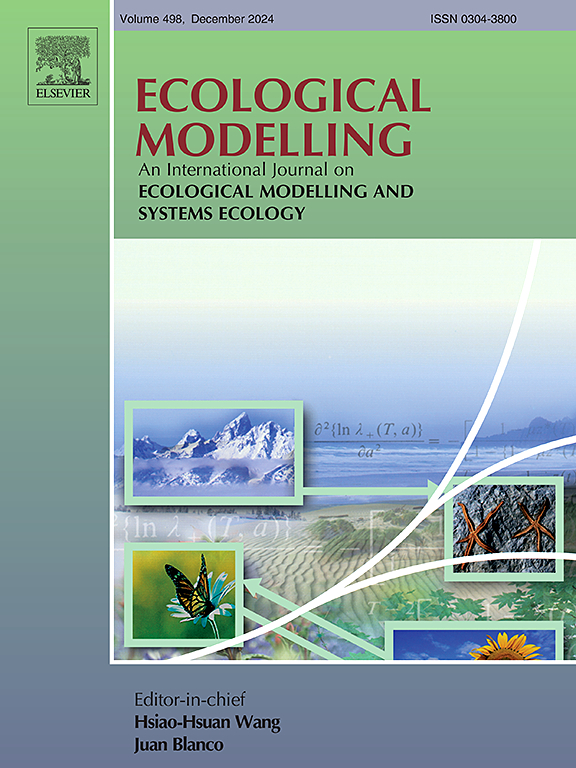Dynamic energy budget modelling of anuran metamorphosis
IF 2.6
3区 环境科学与生态学
Q2 ECOLOGY
引用次数: 0
Abstract
The metamorphosis of aquatic anuran tadpoles to the air-breathing (terrestrial) tetrapod life form is a process that is sensitive to the impacts of natural and anthropogenic stressors. Therefore, metamorphosis is of particular interest in environmental hazard and risk assessment. Current Dynamic Energy Budget (DEB) models that deal with anuran metamorphosis do not have a particular focus on the plasticity of the metamorphosis climax and can thus not be used to evaluate those impacts. In order to remedy this issue, we have developed two independent modeling modules describing anuran metamorphosis, and its plasticity and implemented them in the standard DEB model. Our model meets three important criteria. First, adequately fed tadpoles should be able to emerge as viable frog/toadlets, which is important as tadpoles do not feed during the metamorphosis climax. Second, the model should allow the partial repurposing of structural mass, e.g., resources contained in the tail and gills, during the metamorphosis climax. Third, the model should be able to predict that moderate temperature increases will cause frog- and toadlets to emerge quicker and at a smaller size. The model successfully describes various endpoints, such as the start and end of the metamorphosis climax, and weight and length of the tadpoles from hatching to the completion of metamorphosis as functions of food availability and temperature. This was done for anuran species from four distinct families, namely the common frog Rana temporaria (Ranidae), the common toad Bufo bufo (Bufonidae), the African clawed frog Xenopus laevis (Pipidae) and the gray tree frog Dryophytes versicolor (Hylidae). It is to be expected that the developed modules can be universally applied to other anuran species and likely also to other amphibian species such as urodeles that also undergo metamorphosis. We propose to use this model for establishing a normal operating range that can be used as a baseline in the environmental hazard and risk assessment of pesticides.
anuran变态的动态能量收支模型
水生无尾蝌蚪向呼吸空气(陆地)的四足动物生命形式的蜕变是一个对自然和人为压力因素影响敏感的过程。因此,变态是特别感兴趣的环境危害和风险评估。目前的动态能量预算(Dynamic Energy Budget, DEB)模型没有特别关注变质顶极的可塑性,因此不能用于评估这些影响。为了解决这个问题,我们开发了两个独立的建模模块来描述anuran变态及其可塑性,并将它们实现在标准DEB模型中。我们的模型符合三个重要标准。首先,充分喂养的蝌蚪应该能够成为可存活的青蛙/小蝌蚪,这一点很重要,因为蝌蚪在变态高潮期间不进食。其次,该模型应允许在变态高潮期间部分重新利用结构质量,例如包含在尾部和鳃中的资源。第三,该模型应该能够预测适度的温度升高将导致青蛙和小蟾蜍更快地出现,并且体型更小。该模型成功地描述了各种端点,如变态高潮的开始和结束,以及蝌蚪从孵化到完成变态的体重和长度作为食物可得性和温度的函数。研究对象是四个不同科的蛙类物种,即普通蛙蛙(蛙科)、普通蟾蜍蟾蜍(蟾科)、非洲爪蛙(鼩科)和灰树蛙(水螅科)。可以预期,这些已开发的模块可以普遍应用于其他无尾动物物种,也可能适用于其他两栖动物物种,如也经历变态的尾猿。我们建议利用该模型建立一个正常的操作范围,作为农药环境危害和风险评估的基线。
本文章由计算机程序翻译,如有差异,请以英文原文为准。
求助全文
约1分钟内获得全文
求助全文
来源期刊

Ecological Modelling
环境科学-生态学
CiteScore
5.60
自引率
6.50%
发文量
259
审稿时长
69 days
期刊介绍:
The journal is concerned with the use of mathematical models and systems analysis for the description of ecological processes and for the sustainable management of resources. Human activity and well-being are dependent on and integrated with the functioning of ecosystems and the services they provide. We aim to understand these basic ecosystem functions using mathematical and conceptual modelling, systems analysis, thermodynamics, computer simulations, and ecological theory. This leads to a preference for process-based models embedded in theory with explicit causative agents as opposed to strictly statistical or correlative descriptions. These modelling methods can be applied to a wide spectrum of issues ranging from basic ecology to human ecology to socio-ecological systems. The journal welcomes research articles, short communications, review articles, letters to the editor, book reviews, and other communications. The journal also supports the activities of the [International Society of Ecological Modelling (ISEM)](http://www.isemna.org/).
 求助内容:
求助内容: 应助结果提醒方式:
应助结果提醒方式:


